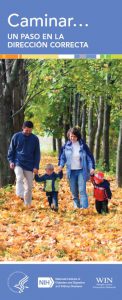Walk into Health, One Step at a Time – WIN Offers Healthy Lifestyle Resources in Spanish
Obesity has become a widespread health problem in the United States that carries with it serious health consequences. More than one-third of U.S. adults, 34.9 percent, and 17 percent of children and teens, are considered obese. Among U.S. Hispanics, the numbers are even higher. Obesity affects 42.5 percent of Hispanic adults and 22.4 percent of Hispanic children and teens.
Obesity may contribute to a host of health conditions, including type 2 diabetes, high cholesterol, high blood pressure, kidney disease, heart disease, and stroke. Some of these conditions affect Hispanics at higher rates. For instance, Hispanic adults have a higher rate of diabetes than non-Hispanic whites: 12.8 percent for Hispanics, compared with 7.6 percent for non-Hispanic whites.
A Step in the Right Direction
 To help promote healthy habits among Hispanic populations, the National Institute of Diabetes and Digestive and Kidney Diseases’ (NIDDK) Weight-control Information Network (WIN) has translated many of its resources on physical activity and healthy eating into Spanish, including Walking…A Step in the Right Direction!
To help promote healthy habits among Hispanic populations, the National Institute of Diabetes and Digestive and Kidney Diseases’ (NIDDK) Weight-control Information Network (WIN) has translated many of its resources on physical activity and healthy eating into Spanish, including Walking…A Step in the Right Direction!
Walking is the most popular physical activity among adults and is a great way for people of all ages and sizes to get and stay active. You can walk almost anywhere and, except for comfortable walking shoes, don’t need special sports gear or clothes. Best of all, walking is free and safe to do for most people.
In addition to the physical activity, walkers may benefit from fresh air; sunshine, a natural source of vitamin D; and a change of scenery. Walking is also a great way to spend time with friends and family members:
- Invite them to be walking buddies or form a walking group.
- Take children or grandchildren to the playground.
- Explore a new part of a city or town with a spouse or partner.
On rainy or cold days, or to beat the heat, an indoor shopping mall can be a great place to walk.
Walking is also an easy physical activity to fit into even the busiest daily schedules and routines. For instance, if a 30-minute block of time just isn’t doable, walking can turn into three, quick, 10-minute bursts of activity:
- during a lunch or coffee break
- in the morning and evening going to and from the bus stop, subway station, or parking lot
- after work when walking the dog
WIN’s resource on walking has more information on walking safely, making walking a healthy habit, and creating a walking program.
More resources and information is available on NIDDK’s website.
Editor’s note: This post was first published on ODPHP’s Be Active Your Way blog.